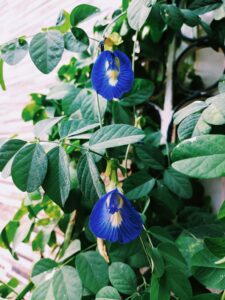
The Butterfly Pea Flower, scientifically known as Clitoria ternatea, is a vibrant spectacle commonly found adorning the streets, forests, and gardens across Okinawa. This hardy perennial vine is celebrated not just for its striking blue petals but also for its versatility in both cultural traditions and health applications.
Historical Insight
The earliest documented mention of the Butterfly Pea was by Georgius Everhardus Rumphius, a Polish naturalist who observed the plant during his visit to Indonesia in 1678. Rumphius highlighted the plant’s distinctive beauty and potential uses, setting the stage for centuries of interest in its benefits.
Cultural Significance
In cultural practices, the Butterfly Pea holds a place of reverence. Known as Aparajita or Shankhpushpi in certain traditions, it is closely associated with the worship of Goddess Durga. During religious festivities, the flower is used in offerings, symbolizing purity and spiritual growth. Its role extends beyond aesthetics, being recognized as a brain tonic and memory enhancer, traditionally used to improve cognitive functions.
Health Benefits
The Butterfly Pea Flower is a powerhouse of antioxidants, such as proanthocyanidin and anthocyanin—compounds also found in blueberries, raspberries, and blackberries. These antioxidants support skin health by stimulating collagen production and promoting elastin synthesis, helping maintain skin elasticity and texture. Considered a heavenly plant in Ayurveda, it is a Pitta, fire and Kapha, water and earth, pacifying herb.
Recent studies suggest that the regular consumption of Butterfly Pea tea can offer health benefits ranging from improved mental clarity to enhanced vitality, making it a prized ingredient in the wellness community.
Practical Uses
To enjoy the benefits of Butterfly Pea, one can easily prepare a soothing tea. Simply steep the dried flowers in hot water and watch the brew turn a deep blue. Adding a splash of citrus, such as lemon juice, transforms the tea into a vibrant pink-purple, making it not only delightful to taste but also a feast for the eyes.
Beyond its use as a tea, the Butterfly Pea Flower is also used in various culinary and cosmetic applications, demonstrating its versatility. Its mild flavor and striking color make it a popular choice for naturally coloring foods, while its skin benefits are increasingly harnessed in beauty products.

Conclusion
The Butterfly Pea Flower is more than just a visual treat; it’s a botanical wonder that bridges the gap between tradition and modern health practices. As research continues to uncover its myriad benefits, the Butterfly Pea remains a symbol of natural beauty and wellness, deeply rooted in the heritage of Okinawa.
Incorporating this herb into daily rituals can be a simple yet profound way to enhance one’s health and celebrate cultural heritage—a testament to its enduring legacy.
By understanding and utilizing the Butterfly Pea Flower, we embrace a piece of Okinawa’s rich biodiversity and cultural heritage, bringing a touch of its mystical charm into our lives.
Moon Mylk Herbal Tea Infusion
What of my favorite way to use Butterfly Pea flower is making SOMA Moon Mylk. But you can spice up this gentle sleep enhancing nervous system calming vegan milk by infusing just a bit of Lavender and Mint first, then add our Moon Mylk into the mix. If you’d like, add a splash of soy or almond milk and voila!
